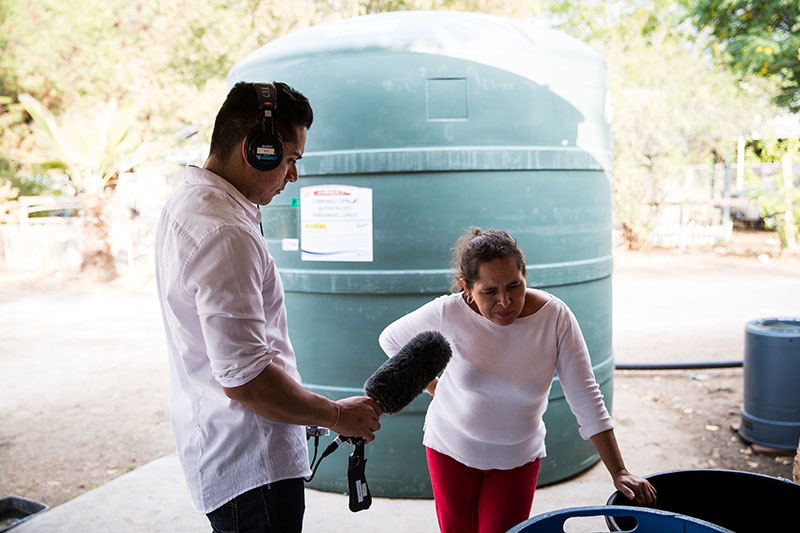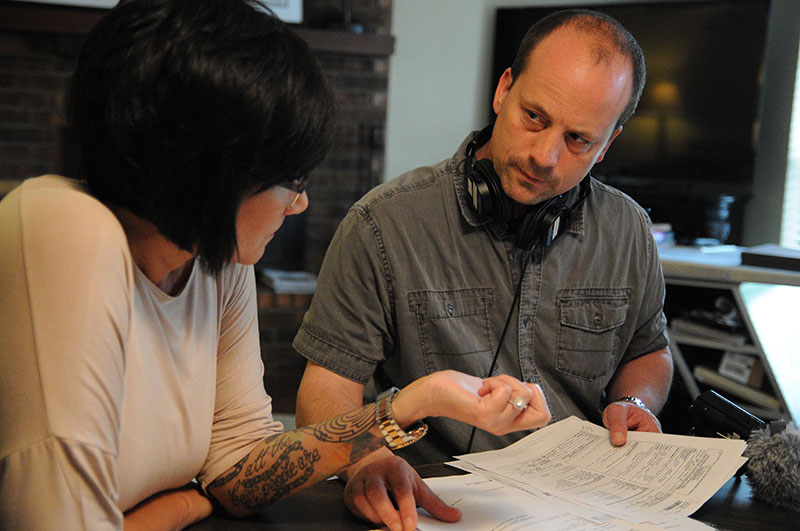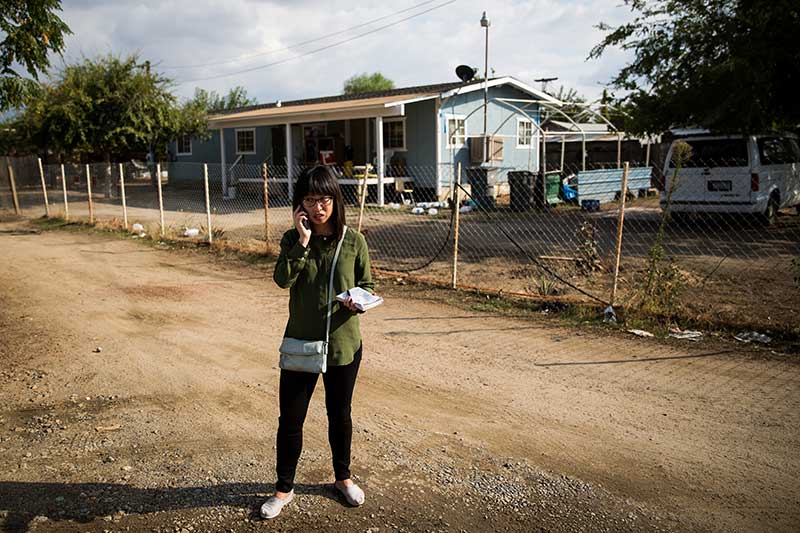In 2014, The Center for Investigative Reporting found itself at a crossroads: Cut much of its staff or create a full-time radio show. That was the choice then-editorial director Mark Katches says the organization faced. “The burn rate can be a pretty scary thing to witness when there is very little revenue coming in to cover your costs,” he adds. “You can’t just sit still and watch everything go up in flames.”
The quandary wasn’t unique to the nation’s oldest nonprofit investigative journalism outfit, though the scale was unprecedented. For decades, its small staff fluctuated alongside project-by-project financial support, publishing hard-hitting exposés wherever it could: TV, magazines, books. During the late-2000s surge in nonprofit journalism funding, CIR was able to build a bona fide investigative newsroom that partnered largely with California newspapers and public media. The organization counted about 70 in its ranks by 2012.
“We went into it with the idea that if you do great journalism, you would build something that would last,” says Katches, who came on in 2009. “The sad reality was that all of those awards and recognition, all the good journalism we did, wasn’t enough in the nonprofit world, where people write checks for two or three years and then move on to the next bright and shiny thing.”
The predicament left CIR searching for its next chapter. It formally began with a July 2014 press release trumpeting millions in new funding to jumpstart Reveal, an hourlong public radio show and podcast. The announcement commenced perhaps the most intense period of evolution in CIR’s long history.

CIR’s Emmanuel Martinez reports on a drought-stricken California community that relies on water tanks for sustenance. (Photo courtesy of Reveal.)
The organization’s goal is to carve out a home for investigative reporting on a medium without a long tradition of it. Its challenge has been to maintain the soul of the organization while carrying out massive internal change. The creation of a self-contained platform for CIR’s reporting is a fundamental shift for the nonprofit, which has traditionally relied on outside partners to distribute its work to a broader audience. Now, CIR aims to control its own means of publication—and nurture its own following—while creating a megaphone for partners’ work. So far it has been a selling point for fundraisers, as it gives CIR direct access to a national, mobile-friendly audience.
“To sustain any type of investigative reporting, it requires you to think differently,” CEO Joaquin Alvarado says. “We’re big enough to do that. That’s our responsibility.”
CIR’s current ambitions carry considerable risks. A weekly publishing schedule is a tight window for projects that take months of reporting, and keeping pace over the long run will require deft coordination with a sprawling web of radio and non-radio partners. The quality and quantity of this outside work will play a large part in determining Reveal’s fate.
Sometimes it’d get so tight that we’d have to go on unemployment for a while until some grants came in.”
Some of CIR’s team has been skeptical of the wholesale shift in publishing strategies, fearful that managing so many moving parts would inevitably distract from their core work. Roughly 20 staffers have left since 2014, taking firepower to the likes of ProPublica, The New York Times, The Marshall Project, BuzzFeed, Google, Apple, The Guardian, Forbes, and even a few audio outlets. The organization has responded largely by hiring a slew of radio veterans, adding production know-how before Reveal moved to a weekly schedule in January.
“We’re taking a huge percentage of our nonprofit budget and making a huge gamble to make a platform for investigative journalism,” says Nathan Halverson, a reporter who joined CIR in 2014 after years in newspapers. “It might not work. Reveal might fail. But for me, in my soul, it feels better to be at a place that’s trying to do something really big.”
Indeed, this is the latest iteration of something really big. A few current staffers joke that CIR has been in constant transition. Others who departed recently frame the ongoing transformation as a borderline identity crisis. “CIR has never been afraid of change in the way most newsrooms are,” says one former staffer, who requested anonymity out of deference to past colleagues. “But that also means that it won’t really stick to anything long enough to get really good at it—and to let people catch up. I feel like we often start these new initiatives and projects, and then we abandon them.”
The current proposition, Reveal, is at once risky and exciting, and in many ways that’s a refreshing combination. But it also raises a broader question that commercial media outlets have debated for much of the past decade: how to square an organization’s core mission with its need to evolve—and survive—in the digital age. Raising money to fund investigative journalism is a Sisyphean task, and CIR has bet that it can innovate its way to financial sustainability.
The burden was smaller with past versions of CIR, which, in the decades following its 1977 launch, typically employed less than a dozen. Nonprofit journalism was in its infancy, and funding was scarce. “Sometimes it’d get so tight that we’d have to go on unemployment for a while until some grants came in,” says David Weir, one of three co-founders.
CIR partnered with outside organizations to produce stories for TV programs like Frontline and magazines like Mother Jones, turning some projects into books. “We always tried to adhere to the freelance mantra, which was Sell the same story as many different ways as you can,” adds Dan Noyes, another co-founder. The scrappy outfit produced periodic but massive investigations on topics such as the Black Panthers or the export of banned pesticides to the developing world. The objective was to radically alter readers’ or viewers’ understanding of an issue.
Still, convincing outside donors to support journalism in the 1980s and 1990s was a hard sell, and there have always been strings attached. Even now, outside money often focuses coverage on specific topics, such as criminal justice or the environment.
In the mid-2000s, however, philanthropic response to the implosion of print advertising sparked something of a revolution. A spigot of cash opened onto fledgling nonprofits sprouting nationwide, while journalists jettisoned by legacy media provided a deep talent pool from which these new organizations could draw. Today, there are more than 100 of them across the United States.

Longtime CIR reporter Trey Bundy has investigated child sex abuse among Jehovah’s Witnesses for much of the past year. (Photo courtesy of Reveal.)
Just a few giants emerged in this new environment, taking various approaches toward growth. The Texas Tribune has gradually built out its state-focused newsroom with the help of revenue from live events and corporate sponsorships. The Center for Public Integrity attempted to create a daily news operation called iWatch in 2011, though the experiment failed to attract an audience and keep foundations interested. The organization had to lay off about a third of its staff in response, and has since returned to stability with a balance of big projects and quick analysis. ProPublica, widely recognized as best in class, launched in 2008 with a $30 million commitment from the Sandler Foundation. That financial runway provided room to not only attract first-rate talent for the newsroom, but also to establish its brand and diversify funding sources.
“More sophisticated funders do understand that it’s necessary to keep the lights on,” ProPublica President Richard Tofel says.
CIR didn’t have such a financial cushion in place in 2009, when it began a period of intense growth. Reveal is a response to the early miscalculation that funders would fall in line quickly enough to sustain that growth. Departures aside, the product has so far succeeded in keeping a much larger version of CIR intact.
“What they’re doing is historically important and different,” says Charles Lewis, who founded CPI in 1989. “It also, like any new entrepreneurial thing, presents risks … . Starting something is the easy part. Sustaining it is the hard part.”
The dominoes of change that led to Reveal began to fall in 2008, as the bottom was dropping out of American newspapers and investigative reporting was collapsing around the country. Enter: Robert Rosenthal, former managing editor of The San Francisco Chronicle and, before that, executive editor at The Philadelphia Inquirer. CIR’s new executive director moved quickly to institutionalize a system in which the newsroom, which was just a handful of staffers at the time, would collaborate with partners across media to publish numerous versions of the same story concurrently, maximizing impact in various markets.
Rosenthal eventually gained traction with a few big funders, including the Knight and Hewlett Foundations, for a state-focused outfit essentially aimed to plug growing holes in California media’s collective enterprise efforts. He also hired Katches, then an investigative editor at the Milwaukee Journal Sentinel, to lead the project.
California Watch’s first story, on waste in the homeland security grant system, was published in September 2009 across TV, radio, and digital outlets, not to mention front pages of roughly two-dozen newspapers that combined for 1.8 million subscribers. CIR developed a distribution network from this blueprint, working with partners to localize stories or adapt them for various formats, and charging meager content fees of usually a few hundred bucks per piece.
Katches proved an intense and charismatic leader as he built a talent-rich, newspaper-style investigative team within CIR. Staff grew to more than 30 as the organization filled a trophy case full of awards. “We started to become a known quantity in California,” says Will Evans, who reported for CIR from 2005 to 2008, and then returned in 2011. “You’d call and people would actually know who you were.”
Whereas ProPublica is The New York Times of nonprofits, the Alvarado-led CIR has become its Silicon Valley equivalent.
Still, the financial reality of that success—CIR’s annual budget had ballooned to $4.6 million by 2011—wasn’t as bright. Key funders walked away, citing a desire for more national focus. “The model evolved to follow where the money was,” Rosenthal says. As CIR began exploring this shift in 2012, it merged with another local nonprofit, The Bay Citizen, which published Bay Area news and features in The New York Times. Rosenthal helped convince many of The Bay Citizen’s funders to support this larger, harder-edged organization. All together, the move essentially doubled CIR’s revenue and staff overnight, to more than $11 million and 70 employees, respectively.
On the rise
CIR revenue and expenses over the past eight years
- Total Revenue
- Total Expenses
Sources: Nonprofit tax forms and CIR internal documents
The organization set out on a yearlong strategic planning process, which led to the consolidation of The Bay Citizen and California Watch under the CIR name. It was during this period that Alvarado, hired in May 2012 as the organization’s first-ever chief strategy officer, began turning it into something of a laboratory for the delivery of journalism. Whereas ProPublica is The New York Times of nonprofits, the Alvarado-led CIR has become its Silicon Valley equivalent. “We’re in the Bay Area—crazy is OK sometimes,” he says.
Alvarado took more active control of the distribution and engagement team, which began experimenting with live events such as investigation-fueled theater productions. The team gradually turned attention away from California Watch’s distribution strategy.
For Alvarado, relying on publishing partners to reach audiences was “an existential threat” both to CIR and investigative journalism broadly. “If you did not own and control your platform as an individual organization—or as a cohort with the resources and openness to collaborate—you were not going to survive.” He worked intensely on a YouTube channel that would curate investigative content from partners, an expensive project that “we learned an insane amount from,” he says. Along with Susanne Reber, who joined CIR in 2012 after two years heading NPR’s first-ever investigations unit, Alvarado began exploring a similar idea in audio.

Joanna Lin joined CIR as a California Watch reporter in 2010, and is one of more than 20 staffers who’ve departed from the organization in the past two years. (Photo courtesy of Reveal.)
“There was this vacuum for investigative material on public radio,” Reber says. While NPR has seen early success with its nascent investigative effort, individual public radio stations don’t often have the resources for months-long projects. Podcasts, meanwhile, tend to veer toward explanatory storytelling. Reber and Alvarado believed a CIR-powered program could fulfill unmet demand for deeper reporting. “It sounded a little crazy, and it was,” Reber says. “But it was sitting right there as an obvious strategic play.”
CIR joined up with the Massachusetts-based PRX to produce a trio of Reveal pilot episodes. The first, released in September 2013, won a Peabody for a segment on how the Department of Veterans Affairs was overprescribing painkillers to vets. Two more the following year appeared to further validate the hypotheses. “We thought we would have 10 stations carry the pilots,” Alvarado says. “We actually had 150.” Perhaps more importantly, the prospect of a CIR-controlled publishing platform soon excited funders, including the Logan Foundation, to the tune of millions.
Staffers were pleased with this early success, though most had been detached from the long phase of experimentation leading up to it. Some bristled at what they saw as new media evangelism—jazz hands—that distracted from the core mission. The sentiment was reinforced by confusion over the organization’s chain of command. In July 2014, Katches left to pursue his dream of running a regional newspaper, The Oregonian, rather than lead this new vision of CIR. Alvarado was soon after promoted to CEO as Rosenthal gradually moved away from many day-to-day operations.
“I left because I got a great job offer, but I didn’t know where [CIR] was headed,” says Ryan Gabrielson, who departed for ProPublica in 2014. He was one of about a dozen staffers who left that year. ”In the end,” Gabrielson adds, “CIR was about being experimental in the age of media disruption. It wasn’t what I signed up for.”
Any confusion regarding newsroom leadership was heightened by a formal vaccuum last year, when Katches’ replacement, Robert Salladay, joined a new project to create a Reveal-branded documentary series. Amy Pyle, who joined CIR in 2012 after a long career in newspapers, took over in the interim and was finally given the editor in chief title in March.
“The lengthy EIC hiring process was helpful for this organization, in that we all learned a lot about each other,” Pyle says. “But it also left us in limbo for quite some time.”
Throughout 2015, Reveal ran on a monthly schedule as CIR began building out the partnership network expected to supply most of the weekly show’s content. PRX expanded the program’s distribution to numerous new member stations. The newsroom honed more audio-friendly storytelling styles through bootcamps for reporters and editors. It also produced a handful of stories to bank in advance of the January 2016 move to one hour of programming a week.
“That year was really important for us because it gave us so much time to think about our workflow,” says Meghann Farnsworth, managing director for distribution and engagement. “But, as with anything, you don’t know how it’s going to be until you’re into it.”
While Reveal is not an NPR-quality listening experience so far, it’s a remarkably sharp radio program and podcast given CIR’s lightning transition. Host Al Letson, part navigator, part passenger, leads listeners through topically themed episodes generally broken down into a few segments apiece. CIR reporters have dropped illuminating stories on the American trapping boom, discrimination in the temporary jobs sector, and religious day care centers, among other topics.
The new medium has forced staffers to rethink the way they tell stories at the most basic level. They still publish text investigations on CIR’s Reveal-branded website and, occasionally, with outside partners. But the typically data- and document-heavy work must be adapted into more radio-friendly formats to travel over the airwaves. CIR producers sonified Oklahoma seismic data into a crescendoing melody that conveyed how hydraulic fracturing has been tied to a spate of earthquakes in the state.
Clip begins at 38:04
In a segment on abuse of foreign aid to humanitarian organizations, CIR reporters went to Malawi to question a key subject, capturing a damning interview on tape.
Clip begins at 36:20
In March, each new episode of the podcast was downloaded about 100,000 times, while Reveal’s back catalogue drew 150,000 additional downloads. More than 250 radio stations also carried the show each week, including in eight of the top 10 markets, and CIR brass say they expect to reach upward of 275 this summer. “For a show that is this challenging? Right out of the box that’s a really good number,” adds PRX’s John Barth, who leads distribution efforts. WBEZ’s This American Life, by comparison, claims more than 500 stations and 2.1 million listeners.
The partner network has also born early fruit. In late January, just as the Flint water crisis was drawing national headlines, CIR contracted an entire hour of programming from Michigan Public Radio. Other partners so far have ranged from American nonprofits like ProPublica, to international partners like the UK-based Bureau of Investigative Journalism, to public radio outlets scattered across the United States.
The question going forward is whether CIR can manage enough partner stories to allow its staffers to continue drilling deep into their own pieces. Reveal’s content ratio—initially estimated at one-third CIR, two-thirds outside work—has hovered around 50-50 this year. “But we don’t want to stretch that too far,” says Reber, now Reveal’s executive editor, “because we want to make sure our investigations at CIR have pride of place on the show.”
The organization has five contracts for producing multiple Reveal stories annually, with The Center for Public Integrity, KQED, The Investigative Fund at The Nation Institute, The Texas Tribune, and Houston Chronicle. The latter two share a full-time staffer with CIR, which hopes to grow this core partner group to eight or 10 organizations. Reber, who is moving to Washington to manage CIR’s East Coast partnerships, also plays matchmaker with potential collaborators. “We have stuff on the books right now well into the summer and fall,” she said in March. “And we have stuff that we know will come in 2017.”
Now the onus will be on them not only to package journalism for various forms of consumption, but also to connect audiences across media so they don’t lose anything in translation.
Turning this mixture into a cohesive show will largely fall on the shoulders of Executive Producer Kevin Sullivan, poached from NPR and WBUR’s Here and Now in late 2014. “My original concept was to have shows done a month ahead of time,” Sullivan says. “What I’m finding is that is not happening. We are often finishing the show on the day we have to upload them … . But they’re in really good shape.”
The newsroom has set aside funds so it can acquire full hours of programming throughout the year. “We want to do something really major once a quarter, either by purchasing a full hour or doing something huge ourselves,” adds Sullivan. “That’s how we’ve set up our budget.” Of the first 16 episodes on the weekly schedule, one has been a rerun and another a decidedly non-investigative, though interesting, feature on Donald Trump supporters.
CIR’s investigative team remains huge—19 reporters by Pyle’s count. “My focus is to make sure what comes out of our core staff is the hardest investigations we are doing, because we know that the stories partners pitch are sometimes not as heavily investigative as CIR is accustomed to,” Pyle says. “A lot of it is coming out of radio [outlets], which often has a more exploratory approach. We juggle a lot, and we try to always have another show in the wings in case something falls through.”
She’d like each of her reporters, at minimum, to gather sound for two segments every year, enough for roughly 30 minutes of Reveal. “We also plan to seek out and nurture investigative skills in the radio producers we hire whenever possible,” she adds.
While the audio-first mentality adds a new degree of difficulty to the CIR newsroom’s work, staffers say fears of sustaining an hour-long show each week haven’t materialized. “Ask me another year from now and I might give you a new perspective,” says Christina Jewett, a longtime reporter and self-described “radio superfan” who’s jumped into the new medium with vigor. “So far I haven’t felt pressure to produce more. But our metabolism is going to have to change again, to be a little bit more nimble.”
That will be especially necessary for CIR to also build out its digital presence on RevealNews.org, which internal metrics show averages about 260,000 pageviews each month (Tofel claims ProPublica draws more than 2 million). Jewett’s recent investigation into profiteering in California’s worker comp system ran as a 4,000-word piece on the site—a version also appeared in The Sacramento Bee—and as a 16-minute segment on Reveal. Jewett penned a sidebar to the story as well, along with a follow-up the next week.

Filmmaker Zohreh Soleimani produced and directed a CIR film on tribal marriage custsoms in Afghanistan. The piece appeared on The New York Times’ website. (Photo courtesy of Reveal.)
“If you cross-reference the print and radio piece, there’s going to be a lot more facts in the print,” says Jewett, speaking generally about the formats. “That’s the nature of the media. But the emotion you can get with audio storytelling is far more than that of print.”
That difference ties into a broader critique leveled by some former staffers, who argue that audio’s narrative-driven style makes it more difficult for stories to highlight systemic flaws. They have a point: Reveal segments typically zero in on a few characters, shaving off some context more easily conveyed visually or through text. Audiences who listen to Reveal without reading CIR’s corresponding written stories, which typically reach fewer people online, lose some of that big-picture analysis.
But it’s also true that the trend toward more vivid, character-focused narratives extends across formats. “Everybody is aware that all the great documents and data in the world are not going to give you a very interesting piece for digital media,” Pyle says.
So CIR staffers will continue walking a familiar line to adhere to the old mantra: Sell the same story as many ways as you can. Only now the onus will be on them not only to package journalism for various forms of consumption, but also to connect audiences across media so they don’t lose anything in translation. CIR’s staff has upped efforts to lead listeners and readers between stories through in-show callouts, social media engagement, and a weekly newsletter, among other tactics. They will soon be doing so without Farnsworth, head of distribution and engagement, who will leave for Vox in May.
Taken together, it’s no small task. But, already, CIR has begun looking toward its next platform. The new project of a small team that includes Salladay is exploring how to adapt CIR stories for the likes of Amazon, Hulu, or Netflix—fuller multimedia integration under the Reveal banner. It comes despite the departures of three video producers over the past six months, two of whom say they left largely because they didn’t want to pursue radio.
“We have to acknowledge that Reveal is helping with our survival,” Salladay says. “You have to adapt. You have to figure out what the next thing is.”
Correction: An earlier version of this article stated that Robert Salladay is leading a new Reveal-branded video project. He is part of a small team working on it.
David Uberti is a writer in New York. He was previously a media reporter for Gizmodo Media Group and a staff writer for CJR. Follow him on Twitter @DavidUberti.

